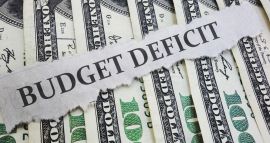

The budget deficit why it matters
Contributing Writer //November 2, 2023//
The budget deficit for fiscal 2023 was $1.7 trillion. Nobody cared. Projected budget deficits for the next 10 years never get smaller and within five years are expected to exceed $2.5 trillion. As a result, the Treasury will add $20 trillion to outstanding debt in the next decade.
Debt in relation to GDP will climb to a record high level. As the amount of debt outstanding climbs, the interest expense will increase commensurately. Today interest represents 2.5% of GDP. It is likely to reach 3.7% by 2033. Looked at in a slightly different way, interest payments today represent 15% of GDP. By 2033 they should climb to 20%. And by 2053 will be 35% of tax revenue.
To pay the mounting interest bill other categories of spending must get reduced. This means that tough choices lie ahead.
Today, entitlements like Social Security, Medicare, and Medicaid represent about two-thirds of all government spending and would be prime candidates for reduced spending. But politicians never want to cut entitlements. Less money for defense? In today’s increasingly dangerous world that seems foolish . What about education? Infrastructure? The bottom line is that the budget deficit is spiraling out of control and our leaders in Washington need to make a serious effort now to rein in spending. But with divided government likely to continue for some time to come the odds on that actually occurring seem remote.
The budget deficit for fiscal 2023 was $1.7 trillion. The Congressional Budget Office envisions deficits between $1.6 and $2.8 trillion every year for the next ten years. By definition a deficit means that the government spends more money than it receives from taxes and must issue an equivalent amount of debt to pay its bills.
Over the course of the next decade the government is expected to add $20.0 trillion to the amount of debt outstanding. Prior to the recession debt in relation to GDP was 79%. Today it is 100% and by 2033 the CBO expects it to be a record 119%. The previous record high debt/GDP ratio was 106% after World War II. It subsequently fell quickly as defense spending plunged. That is not going to happen today.
One of the government’s many expenses is interest on the public debt. Given the massive increases in debt outstanding that began around the 2008-09 recession, jumped sharply in the wake of the 2020-2021 recession, and are expected to continue climbing for the next decade, interest on the public debt has risen from 1.5% of GDP prior to 2008 to 2.5% today and is expected to climb to 3.7% of GDP by 2033. It has never been higher. The CBO also does a longer-range budget forecast. By 2053 interest payments are expected to be 6.7% of GDP.
But those are just numbers. They seem disquieting, but the seriousness of the problem may not be readily apparent. Let’s think about this in a different way. The government collects taxes from each of us. Every year it spends more than it collects in taxes. It must borrow the difference to pay its bills. Every year the amount of debt outstanding increases which means that interest on that outstanding debt also increases. Today interest represents 15% of all tax revenue. The remaining 85% of tax revenue can be used for spending on everything else. But by 2033 the CBO estimates that interest will be 20% of tax revenue.
By 2053 the government will have to allocate 35%, or roughly one-third of its tax revenue, to pay interest. That means that the spending on everything else will drop to 65%. So between 2023 and 2053 the amount of spending on defense, social welfare, infrastructure, research, education and a myriad of other spending categories, will be cut from 85% of GDP to 65%. That is a cut of 20%. It is hard to see where those cuts will come from.
Even closer to home let’s look at the typical consumer’s budget. The Bureau of Labor Statistics tell us that consumers today spend 33% of their income on housing. Let’s suppose that in the next 30 years consumers go on a spending spree, borrow extensively, and interest payments on credit card bills represent another 33% of our income.
Only one-third of our income will be available to pay for food, gasoline, medical expenses, insurance, education, and vacations. That is simply not going to happen. Consumers cannot afford such a spending spree.
Neither can the government. As budget deficits soar to $2.0 trillion or more, debt outstanding will climb commensurately. And now, thanks to the Federal Reserve, interest rates have risen dramatically. If the government’s spending spree continues, 30 years from now once the interest payments have been made there will not be enough money left for everything else.
The government cannot afford such a spending spree. Something has to give.
From 1980 until 2003, when he retired, Stephen Slifer served as chief U.S. economist for Lehman Brothers in New York City, directing the firm’s U.S. economics group along with being responsible for forecasts and analysis of the U.S. economy. He has written two books on using economic indicators to forecast financial moves and previously served as a senior economist at the Board of Governors of the Federal Reserve in Washington, D.C. Slifer can be reached at www.numbernomics.com.
g















